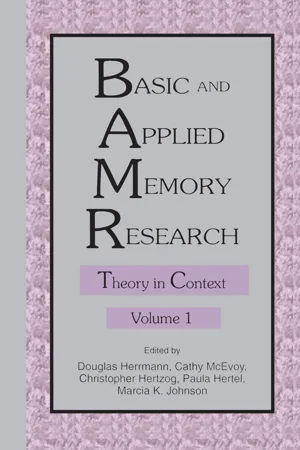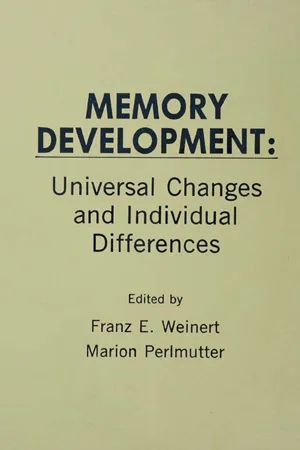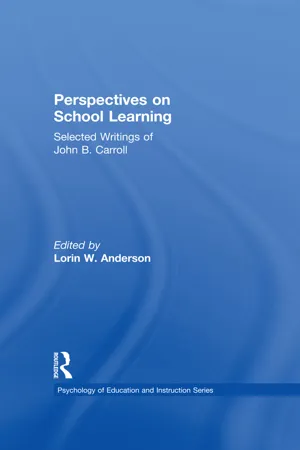Psychology
Individual Differences In Memory
Individual differences in memory refer to the variations in how people encode, store, and retrieve information. These differences can be influenced by factors such as genetics, age, and experience. Understanding individual differences in memory can help psychologists tailor interventions and strategies to improve memory function for individuals with different cognitive profiles.
Written by Perlego with AI-assistance
Related key terms
8 Key excerpts on "Individual Differences In Memory"
- eBook - ePub
Learning and Memory
Basic Principles, Processes, and Procedures, Fifth Edition
- W. Scott Terry(Author)
- 2017(Publication Date)
- Routledge(Publisher)
Individual Differences in Learning and MemoryThe Nature of Nurture: The Genetics of Learning Ability Animal Studies Human Studies Age Differences in Learning and Memory Conditioning Memory Development in Children Aging and Memory Intellectual Deficits Conditioning Memory Learning Disabilities Exceptional Memory: The Mnemonists Gender and Cognitive Abilities Personality and Learning Self-Control Anxiety Learning Styles The Visualizer–Verbalizer Dimension Kolb Sternberg Learning Styles? Social and Cultural Differences Epic Memories Experimental Studies SummaryO ne of the goals of a scientific psychology is to describe general laws. This textbook, which includes the word principles in its title, attempts to specify some general, maybe even universal, principles of learning and memory. There are exceptions to the principles, and individual differences are one source of variation. The combination of genes, physical constitution, environment, and life experiences causes each of us to react somewhat differently to what are seemingly the same situations. The remarkable thing, then, is that there are any general principles at all!It would be impossible to describe the laws for each and every individual. Instead, researchers focus on broad categories of differences. How are children and adults alike or different in their remembering? Are there gender or personality differences that interact with the principles of learning?Two distinctive approaches to research in psychology are the experimental approach and the correlational approach (Cronbach, 1957). The experimental approach focuses on those variables that can be actively manipulated by researchers, in order to demonstrate what effects these variables have on learning. The experimental approach seeks the general principles that transcend individual differences. The correlational approach - eBook - ePub
Basic and Applied Memory Research
Volume 1: Theory in Context; Volume 2: Practical Applications
- Douglas J. Herrmann, Chris Hertzog, Cathy McEvoy, Paula Hertel, Marcia K. Johnson(Authors)
- 2013(Publication Date)
- Psychology Press(Publisher)
Chapter Eight What Are the Functional Bases of Individual Differences In Memory Ability? Patrick Rabbitt Qian Yang University of Manchester, Manchester, EnglandPeople differ markedly in memory ability, as in all other cognitive skills. Nevertheless, there are no satisfactory accounts of individual differences in the efficiency of functional processes underlying memory, possibly because cognitive psychologists have been more impressed by massive individual differences associated with extensive, domain specific practice (Ericcsen, Krampe, & Tesch-Rohmer, 1993) or invention and use of mnemonic techniques (Ericcsen & Chase, 1982; Ericcsen & Poison, 1988). Current models for how the efficiency of the functional processes underlying memory may vary between individuals polarize between identical hypotheses, remarkably without any cross-reference. One psychometric model proposes that all cognitive skills, including memory, load on a single factor of general intellectual ability such as Spearman’s (1927) “g” (for a recent discussion, see Gustafson, 1984). Interest in this somewhat dated view has been revived by the suggestion that “g” can be reified in terms of some particular performance parameter of the functional cognitive system. One suggestion has been information processing speed (Anderson, 1992; Bates & Eysenck, 1993; Brand & Deary, 1982; Eysenck, 1986; Hulme & Turnbull, 1983; Jensen, 1980; Nettelbeck, 1982; Smith & Stanley, 1983; Vernon, 1983, 1985; Vernon & Jensen, 1984). A more recent is “working memory capacity” (Carpenter, Just, & Shell, 1990; Kyllonen & Crystal, 1990). The evidence is modest, but ubiquitous correlations between performance on pencil-and-paper “intelligence tests” (IQ Test Scores, IQTS) and performance indices derived from simple laboratory tasks such as Choice Reaction Time (CRT) or tachistoscopic recognition thresholds (“Inspection Times,” ITs) and supposedly more direct indices of Central Nervous System (CNS) efficiency such as latencies of early, p100 - eBook - ePub
The Foundations of Remembering
Essays in Honor of Henry L. Roediger, III
- James S. Nairne, James S. Nairne(Authors)
- 2011(Publication Date)
- Psychology Press(Publisher)
The work presented in this chapter was heavily influenced by the work of Roediger (2000), in terms of the importance of retrieval processes. Additionally, as will become evident later on, the work presented here was influenced by the Baddeley and Hitch (1974) working memory model, Tulving’s arguments for cue-dependent forgetting (Tulving, 1983), Watkins’s notion of cue-overload (1979), Shiffrin’s elaboration of these concepts into a formal model of cue-dependent search (1970; see also Raaijmakers & Shiffrin, 1981), Glenberg’s emphasis on temporal-contextual search (1987), and Wixted and Rohrer’s work examining cumulative latency distributions in terms of a random search model (1994; Rohrer & Wixted, 1994). Furthermore, the work here has been influenced by Cronbach and others’ (1957; Cohen, 1994; Underwood, 1975) call to combine experimental investigations with individual differences analyses in order to gain a better understanding of the underlying process. Thus, in this chapter we will advocate the view that not only is it important to examine retrieval processes from an experimental point of view, but that investigations of individual differences can also aid us in our understanding of retrieval processes. As proposed by Underwood (1975) and others (Cohen, 1994; Cronbach, 1957), we will discuss an integration of experimental and differential approaches to understanding retrieval processes and individual differences therein. Specifically, we will examine how individual differences in working memory capacity are related to individual differences in retrieval and what this tells us about the nature of working memory capacity and its relation to higher-order cognition.INDIVIDUAL DIFFERENCES IN WORKING MEMORY CAPACITY
Before discussing the relationship between working memory capacity and retrieval, we will briefly describe working memory capacity, how it is measured, and review the importance of working memory capacity in predicting performance on both higher-order and lower-order cognitive tasks. Working memory is considered to be a system responsible for active maintenance and online manipulation of information over short intervals. In our view, working memory consists of a subset of activated traces above threshold (some of which are highly active), strategies for maintaining activation of those traces, and an attention component. Thus, our view of working memory emphasizes the interaction of attention and memory in the service of complex cognition. In order to measure the capacity of working memory, researchers have relied on complex working memory span tasks based on the working memory model of Baddeley and Hitch (1974). Beginning with Daneman and Carpenter (1980), these tasks combine a simple memory span task with a secondary processing component. Initially, the idea was that these tasks would better measure a dynamic working memory system that traded off processing and storage resources. Thus, in these tasks participants are required to engage in some form of processing activity while trying to remember a set of to-be-remembered (TBR) items. As an example of such a task, consider the operation span task, which requires participants to solve math operations while trying to remember unrelated words. Here, participants are required to solve math operations while trying to remember words presented after the operations. At the recall signal participants must try and recall the presented words in the correct serial order. Several variations exist of this basic paradigm, with most variations consisting of different processing tasks. These include reading sentences (Daneman & Carpenter, 1980), solving math operations (Turner & Engle, 1989), counting different colored figures (Case, Kurland, & Goldberg, 1982), and determining if a figure is symmetrical (Kane et al., 2004). Additionally, variation exists in the type of TBR stimuli that is used. These include remembering words, letters, digits, and spatial locations. - eBook - ePub
- Timothy J Perfect, D Stephen Lindsay(Authors)
- 2013(Publication Date)
- SAGE Publications Ltd(Publisher)
Moonwalking with Einstein, also strongly makes the case for practice in the context of memory improvement techniques.In this chapter, we address 12 questions about how and why people’s memory abilities differ. We chose these 12 because, in our experience, they are the most frequently asked questions in university and public lectures on memory. We will argue overall that the two major factors underlying Individual Differences In Memory are the operation of working memory and the knowledge stored in long-term memory, with additional contributions from motivation and personality. Our primary goals will be to show where the differences in memory ability are worthy of note, what might bring about the differences, and how what we know about these differences enhances our understanding of memory. Psychologists periodically call for better integration of individual differences research into our general theorizing (e.g., Cronbach, 1957): This need is at least as great in the domain of memory as elsewhere (see, e.g., Melton, 1967; Underwood, 1975). Surely the range of memory abilities constitutes a major element of memory that must be explained.Table 22.1 shows the twelve questions about Individual Differences In Memory that we will try to answer – or at least to summarize what we know. But before we begin answering these central questions, how can we measure memory in the first place?MEASURING MEMORYThe best known psychometric test designed to measure different memory functions is the Wechsler Memory Scale. Originally developed in 1945 and now in its fourth edition (WMS-IV; 2009), it consists of seven subtests: brief cognitive status exam, spatial addition, symbol span, design memory, logical memory, verbal paired associates, and visual reproduction. These are then combined and reported as five Index Scores: Auditory Memory, Visual Memory, Visual Working Memory, Immediate Memory, and Delayed Memory. When factor-analyzed to determine the underlying traits, the two dominant factors are a general memory factor and an attention/concentration factor (Roid, Prifitera, & Ledbetter, 1988). WMS-IV was designed to accompany the Wechsler Adult Intelligence Scale, fourth edition (WAIS-IV; 2008), which also contains a working memory index made up of two subtests – digit span and arithmetic. The major use of the WMS is as a neuropsychological tool to evaluate people with suspected memory problems, but it can also be used to measure normal memory. - eBook - ePub
Handbook of Learning and Cognitive Processes (Volume 1)
Introduction to Concepts and Issues
- W. K. Estes, W. K. Estes(Authors)
- 2014(Publication Date)
- Psychology Press(Publisher)
at the time when it is stored is a key step. Thus, it is not enough to teach someone a strategy for memorizing, one must also ensure that the subject knows when to use it. Any individual differences in handling immediately presented information will determine the amount of encoding that will be done when a procedure is learned. Thus, the effect of a small difference in the encoding of a problem solving procedure will be repeated every time the person encounters a situation in which the encoded procedure might be a useful approach to problem solving. We suggest that this indirect effect on problem solving may be one of the most important effects of differences in human information processing, and that explicating this effect may be one of the most important reasons for studying these differences.II. CONCLUSION
We began with a critique of the psychometric approach to the study of individual differences in cognition, pointing out that although the techniques developed by psychometricians do provide a reliable means of classifying people along various ability dimensions, they do not give explanations of the mental processes which underly the psychometrically defined abilities. Neither do they give enough information as to why some people are superior to others in these processes. They do not help us find the mechanisms which connect environmental and physiological variables to abilities. We proposed that a satisfactory theory of individual differences should be based on concepts which are rooted in a theory of cognition.While we were reviewing the literature for this presentation, at times we were tempted to conclude that the number of ways in which people differ is so vast that there is no hope of finding order in the chaos. Perhaps the assumption of the factor analysts that mental performance is based on a limited number of ability dimensions is a useful fiction, since it allows the investigators to keep their sanity. We are now more optimistic. There is hope for progress in attacking the problem of individual differences using the models provided by modern theories of information processing. - eBook - ePub
Memory Development
Universal Changes and Individual Differences
- Franz E. Weinert, Marion Perlmutter(Authors)
- 2013(Publication Date)
- Psychology Press(Publisher)
Thus, study of the structures, processes, and functioning of the memory system continues to be a fundamental endeavor of cognitive psychology in the expectation that the findings will advance theoretical ideas and produce practical benefits. The study of memory development plays a significant role in this endeavor. Systematic observation of the ways in which changes in cognitive resources across the life span affect different types of memory performance is likely to encompass a greater range of phenomena than can be obtained in laboratory investigations with adult subjects. In addition, cross-cultural comparisons and training studies allow the investigation of the plasticity of human memory systems. Such studies have the particular value of providing a basis on which instructional treatments and teaching demands can be adjusted to the developmental levels achieved by the learners.Considering the volume of theoretical and experimental work in memory development during the past decades, it is at first glance surprising that the results of current research receive such disparate evaluations in the different chapters of this volume. Whereas some of the contributors note that significant progress has been made in our understanding of memory development (e.g., Borkowski et al., Pressley et al.), others tend to be more skeptical and critical. Thus Perlmutter (this volume) emphasizes that “present understanding of memory is limited by the restrictive focus on only a very special kind of memory, that is on deliberate memory of symbolic information over short time intervals in extremely sterile situations.” Similar deficits are noted by Paris, Ceci et al., Verdonik, and Dixon and Hertzog. In general, although these critiques do not deny that progress has been made within a number of research paradigms, they point to the narrow scope of current definitions of memory development and current methodological approaches. It is worthwhile to examine the progress and shortcomings a little more closely. To this end, I first discuss the highlights of current research on memory development, then attempt to clarify what memory research in developmental psychology really studies, and finally, draw some conclusions concerning the directions that future research should take. - eBook - ePub
Perspectives on School Learning
Selected Writings of John B. Carroll
- L. W. Anderson(Author)
- 2014(Publication Date)
- Routledge(Publisher)
1. Simple judgments of stimulus attributes such as to reveal identity, similarity, or differences between two stimuli. 2. Certain manipulations of STM contents, such as “imaging” or otherwise abstractly representing an item, imaging a figure-in-ground, and mentally rotating a visuospatial configuration.3. “Serial” operations using algorithms from the general logic store (or, more generally, a production system that includes such algorithms). That is, certain elements are operated on, producing new elements. These in turn are operated on, producing still further elements, and so on until the process is terminated (either successfully or unsuccessfully). Individual differences concern the ability to perform these operations efficiently and correctly with whatever algorithm or algorithms are being used. (Of course, individual differences also arise from whether appropriate algorithms are in fact being used, but such differences are assigned to differences in contents of relevant LTM memory stores.)Response Aspects of the FactorsA final column of the table notes whether individual differences may be presumed in the temporal parameters of “response rendering.” This applies to the particular tests offered in the French et al. Kit of Reference Tests for Cognitive Factors. Many of these tests (usually, all tests of a given factor) require the subject to render his or her response by writing words, phrases, or sentences, rather than simply selecting a response. We know that there are individual differences in writing speed (Carroll, 1941) that enter into test correlations. The table notes factors in which such individual differences may play a role, although it may not be that such a role is essential to their measurement.Characterizations of the Factors in Terms of Cognitive ProcessesIn the following “characterizations,” I must emphasize again that the descriptions address only aspects of tasks that involve individual differences. The factors are arranged roughly in terms of the type of memory and the number of cognitive processes that are involved. (This is also the order in which the factors are presented in Table 2 - eBook - ePub
- Kevin Wheldall(Author)
- 2013(Publication Date)
- Routledge(Publisher)
A first step is to identify the variables that are likely to have a practical effect on performance and then to refine methods of assessing them. Over the past 25 years progress has been made in the identification and assessment of specific dimensions of individual difference. Gender has become more prominent as a variable (e.g. Halpern (1992); Skaalvik and Rankin 1994);personality dimensions have been further identified (e.g. Eysenck (1998); McCrae and John 1992); information processing and working memory are better understood (e.g. Baddeley 2000); notions of intelligence have been refined (e.g. Mackintosh 1998), and cognitive style research has advanced (e.g. Riding and Rayner 1998). Advances have also been made in identifying aspects of the home background that affect performance (e.g. Darling and Steinberg 1993). This work has laid the foundation for a further push forward to reconcile outstanding uncertainties.Range of VariablesThere will be differences within the individual, between schools/colleges, within schools/colleges from teacher to teacher, and in the home background, which will each contribute to differences in performance. These could include the following.Variables Particular to the Individual StudentThere are variables within the individual and within the individual’s environment. Within the individual, the variables include present knowledge, intelligence (reasoning), working memory efficiency, anxiety-stability, gender, wholist-analytic style, verbal-imagery style, and introversion-extraversion. This is in approximate order of their likely effect on performance. In considering within-pupil differences, an initial task is to define the individual difference constructs operationally. The basic problem is that most of the above constructs are inferred from behaviour, but not from directly observable origins. This probably also applies to some extent to gender, which may be more of a continuum than a dichotomy.Within the student’s home background, variables include emotional support and stability, genetic and nurture components of intelligence, and the educational and material resources available. Often these differences will theoretically be open to direct inspection, although in practice this will be difficult because of the need to respect privacy, the unwillingness of parents to provide information, and, in the case of older students, the home situation may change with time.
Learn about this page
Index pages curate the most relevant extracts from our library of academic textbooks. They’ve been created using an in-house natural language model (NLM), each adding context and meaning to key research topics.







